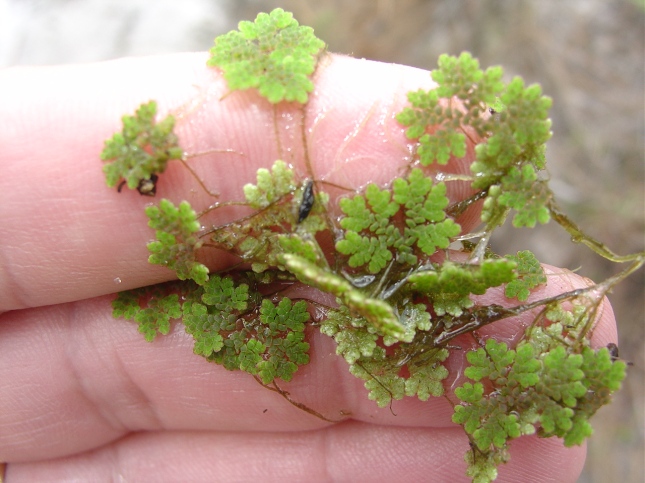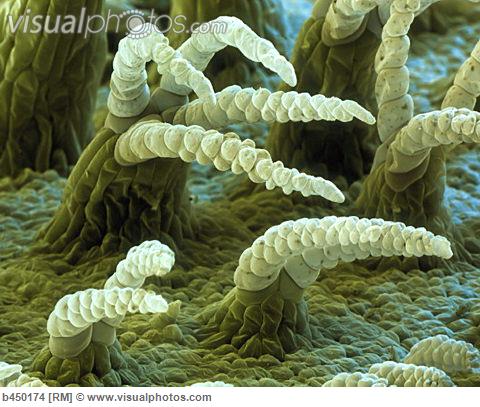Azolla filiculoides and additional species
Salvinia minima and more
This week’s Friday trip was displaced by a scintillating department chair meeting, two life-wasting hours dedicated to e-mailable calendar events, futile parking space rants, program enrollment statistics, personal horn-tooting, and oh-so-witty repartee. My seat-neighbors survived with sneaky smart phone activity. My phone is dumb, so I just stared out the window sullenly, dreaming of native plants and chicken marsala, and wondering what was floating on the polluted drainage ditch across the parking lot.
Upon adjournment, I checked out the ditch and found the pond scum to be largely fertilizer-fed Blue-Green Bacteria (Blue-Green “Algae”), and, better, there were little floating ferns, always fun to see. (They have their own Cyanobacteria, so stay tuned.)
In Florida we have two genera of small floating ferns: Azolla and Salvinia. Each has two Florida species, more or less, with room for debate on exactly which species are present, how they are defined, and exactly where they are native. Let’s not get into all that in our fun little blog, except to mention that the ancient Old World rice paddy species Azolla pinnata seems to have made its Florida debut right here in Palm Beach County.
Both Salvinia and Azolla float with an option of settling onto wet mud when waters recede. Both are abundant in local waters. Both come and go, almost magically, and have the capacity to go forth and multiply—to the extent of utterly covering the water surface, or clogging irrigation pumps.
Sometimes called “Waterferns” or “Mosquito Ferns,” Azollas are the smaller-statured of the two. You could mistake them at first glance for Duckweeds (that’s a different blog). A single Azolla plant can be the size of a coin, floating on the water surface with tiny branches bearing tinier leaves overlapping like shingles. Each plant has a roughly circular irregular and lumpy outline. (Azolla pinnata has an outline like a squashed conifer tree.) They can form small roots, with the absorptive root function supplemented by thin-walled hairs on the leaf surfaces.
Azolla consorts in a symbiotic relationship with Cyanobacteria (often misnomered “Blue-Green Algae”) able to fix nitrogen, that is, transform atmospheric nitrogen into fertilizer. (The German chemist Fritz Haber won a Nobel Prize in 1918 for figuring out how to do this industrially to make fertilizer and to make ammunition.) The symbiotic Cyanobacterium, Anabaena azollae, is impotent in the presence of oxygen, so the fern gives its little friends climate-controlled mucilage-lined gas chambers in hollow cavities in the leaves. Anyone with a microscope can break the fern apart with a needle in a drop of water and see the Anabaena dramatically.
Lots of plant, fungus, and animal species have one-on-one symbiotic relationships with microbes. Inquiring minds might wonder what happens to the intimate relationship when the host undergoes its sexual cycle. How do the host babies wind up with their own microbe? Different strokes for different folks, in Azolla the bacterium rides through the fern’s entire reproductive cycle. Ain’t that somethin’! Each baby Azolla has Anabaena as its birthright, sort of a trust fund baby.
A floating fern that can make fertilizer is a handy asset in a rice paddy, and Azolla has been boosting since ancient times. That’s why Azolla pinnata is sort of interesting here, even if invasive. Did it follow rice cultivation to the Agricultural Area, or just show up on its own accord? (You can imagine 100 ways for it to arrive.)
Salvinias are sometimes called Water Spangles. Our widespread Water Spangle is the Invasive Exotic Salvinia minima, perhaps enjoying a little Global Warming and inching northward. This Tropical American native has spawned reports across the southern U.S. with cameo appearances in northern states. (Taxonomic-nomenclatural confusion and easy mobility complicate assessment of the exact distribution.) It can turn a canal into a green lawn, as I saw recently in Riverbend Park in Jupiter.
Salvinia is easy to recognize. The leaves are in whorls of three. Two leaves are identical, nearly circular in outline, about a centimeter in diameter. (The leaves are larger in S. molesta , which has a couple reports in Florida, but not in our haunts so far.) The third leaf in the whorl looks like a brushy branchy root dangling in the water. The two round green leaves have unwettable surfaces with extreme hairs. In S. minima the hairs look like a scary Halloween tree; in S. molesta the hairs look like an eggbeater.
Don’t look for spores as encountered under the fronds in most ferns. Both Azolla and Salvinia have a special adaptation to the boating life— spores in little hard cases called “sporocarps.”
I have a personal theory that pond scum is going to save the world. What grows faster? Scarfs up pollutants in the process? And utilizes bad carbon dioxide? We’re talking biofuels, and even food. This video will give an idea how fast Azolla can grow —just toss in a little cow dung slurry—and feed the world! (Or at least feed the livestock.) CLICK





sue dingwell
October 7, 2012 at 10:33 pm
Oh those painful hours in faculty meetings – and how I do not miss them!! Thanks, George, for another edifying and entertaining post. I truly enjoy your blog!
George Rogers
October 7, 2012 at 10:57 pm
Hi sue, Hope all your new projects are as much fun as they seem! And I hope the Boss isn’t reading this blog.
Mary Hart
October 8, 2012 at 3:29 am
George, What a constructive use of a boring meeting, which could inspire such a fascinating article. My Susie will bear out your observations on trying to live through such times without expressing her real opinion!!
George Rogers
October 8, 2012 at 6:55 am
Hello Mary, at 7 in the morning. An inability to keep my mouth shut has cost me dearly over the decades! Really. With a grandmother like you, Susie is getting a the best possible launch into working life!
George Rogers, Ph.D.
Horticulture Dept., Palm Beach State College
rogersg@palmbeachstate.edu
561-207-5052
________________________________________
annsbirdventures
October 8, 2012 at 10:32 am
Lovely! I can only hope your boss doesn’t know about your blog. 🙂
George Rogers
October 8, 2012 at 8:55 pm
Hi Ann, Thanks, I hope so too!
Martin
October 8, 2012 at 11:27 am
Sometimes your writing is simply beautiful – what a wonderful introductory paragraph! It should be stolen by the Intro to Writing 101 professors and used in class.
George Rogers
October 8, 2012 at 8:56 pm
Hey Mudfish, Thanks. I wish I could write about catching snook! Been fishing?
Amy Dahan
October 9, 2012 at 1:46 pm
Are either of these species the blue-green algae that I slurp up in my smoothies?
George Rogers
October 9, 2012 at 6:08 pm
From one algae eater to another, the Anabaena is related to, at least at the level of being a Blue-green Alga (Bacterium) as these in the health food store, such as Spirulina. Yum.
Amy Dahan
October 9, 2012 at 1:53 pm
Loved your article, George! Your idea that pond scum will save the world quickly morphed into a sci-fi drama in my mind: The Scary Salvinia that Ate New York will be about a precious little pond scum that ate up all the pollutants, then started consuming plastic margarine tubs, styrofoam, and empty bic pen sticks. That course being complete, it then discovers that the source of all this garbage will make a tasty treat. Remember the alien treatise called “To Serve Man” that turned out to be a cook book on the Twilight Zone?
George Rogers
October 9, 2012 at 6:11 pm
Amy, I see that your brain is super-nourished on green scum. I just got back from the Saigon Grocery in Lake Park where I go to try new algae, fungi, and delicious products alien to the Plant and Animal Kingdoms. That Pacific (and Atlantic, and Indian Ocean) garbage mess is just off the charts.
Steve
November 12, 2012 at 8:03 pm
Great article. A great read about Azolla (likely the most economically important fern in the world) and other ferns is A Natural History of Ferns by Robbin Moran. Curious though, many ferns are reportedly carcinogenic when eaten (fiddleheads). Any knowledge about potential problems of feeding Azolla to livestock (and people)?
George Rogers
November 12, 2012 at 9:03 pm
Steve, I’m afraid I don’t know about Azolla toxicity. Might be Google-able though. I have a funny feeling it might cause a crummy in the tummy.
Keith Rossin
February 27, 2014 at 11:36 am
Wow a floating fern that can fix Nitrogen, every time i come on this site i learn so many new things what a wonderful plant to have floating in your back yard pond. Sounds like a great plant to hook up a hydroponics grow operation too, how exciting!!
George Rogers
February 27, 2014 at 11:41 am
I’ve tried to grow Azolla in the classroom aquarium. It lived a couple months but eventally went downhill. I think there was not enough light. The aquarium has since been moved to a brighter spot, and the next time I see Azolla in a canal (class fieldtrip to Riverbend?), I’ll try some in the tank again. You can put it on a microscope slide and break it apart, and then see the bluegreen bacteria clearly. Very much like “textbook” photos.
Keith Rossin
March 20, 2014 at 12:45 pm
Sounds like a good experiment to try let me know how it goes.
George Rogers
March 20, 2014 at 1:31 pm
Done it a few times—works great. Try it in the Physiology lab room. I try to grow some in the aquarium htere.
Duane
June 22, 2014 at 1:47 pm
Nice post, Azolla is fascinating. I have even theorized on my blog antediluvian salad that many dinosaurs may have fed heavily on the stuff as Azolla has a fossil record well back into the Cretaceous.
http://antediluviansalad.blogspot.com/2014/06/was-deinocheirus-largest-waterfowl-of.html
It certainly makes sense as one tool to sequester carbon.
George Rogers
June 22, 2014 at 3:37 pm
Thanks, John tells me your bog is fascinating…and your thoughts on Azolla as dino salad seem a great idea. After all, it fixes nitrogen, so may be nitro-enriched. Now I’m going to take a look at your blog. BTW, what do you think of the idea that cypress knees might be giant thorns to deter ancient herbivores…including dinos?